
CHEMOSYNTHETIC COMMUNITIES ON REPTILE DEAD-FALLS IN MODERN AND CRETACEOUS SEAS
Robert G. JENKINS1, Andrzej KAIM2, Tamaki SATO3, Jun OKAMOTO3, Haruta UCHIDA3, Kazuhiro MORIYA4, Ren HIRAYAMA5, Yoshinori HIKIDA6, Yasunori KANO7, Takenori SASAKI8, Shozo OGISO1, Azuma TAOKA1, Toshio SEKIGUCHI1, and Nobuo SUZUKI1
1Kanazawa University, Kanazawa, Japan; 2Institute of Paleobiology PAS, Warsaw, Poland; 3Tokyo Gakugei University, Tokyo, Japan; 4Asahi Kohmatsu, Tokyo, Japan; 5Waseda University, Tokyo, Japan; 6Nakagawa Museum of Natural History, Nakagawa, Japan; 7AORI, University of Tokyo, Kashiwa, Japan; 8University Museum, University of Tokyo, Tokyo, Japan.
Corresponding author: robertgj@staff.kanazawa-u.ac.jp
An evolutionary “stepping stone” hypothesis has been formulated to explain the progressive adaption
of some invertebrates to colonize the environments of hydrothermal vents and hydrocarbon
seeps, through the creation of reduced environments from the decay of large organic-falls on the
seafloor (i.e., sunken wood and whale carcasses; Distel et al. 2000). In the Mesozoic, when whales
had not yet appeared, marine reptiles would have been an important source of large organic-falls
on the deep-sea floor. Sea turtles comprise one of the very few groups of large marine organisms
that survived the Cretaceous/Paleogene extinction event. Danise and Higgs (2015) previously reported
bone-eating Osedax worm traces from mid-Cretaceous plesiosaurid and sea turtle bones,
but it remains largely unknown which kind of chemosynthetic invertebrates were associated with
sea turtle-falls. Here we present two examples of chemosynthetic communities on Cretaceous sea
turtles (Mesodermochelys sp.) from the Yezo Group in Hokkaido, Japan. The associated chemosynthetic
fauna is composed of provannid, Hikidea sp. and some other gastropods, as well as thyasirid,
lucinid, and solemyid bivalves. The fauna is similar to those of the Cretaceous plesiosaurid-fall and
hydrocarbon seep communities in the same region. This finding indicates that the chemosynthetic
communities were supported not only by plesiosaurid carcasses but also by decomposing sea turtles.
We also deployed dead loggerhead sea turtle (Caretta caretta) in a shallow marine setting (ca.
11 m deep) in Tsukumo Bay (Noto Peninsula, Ishikawa Prefecture, Japan). We started the experiment
in December, 2013 and over the following 1.5 years, we observed and subsequently recovered several
pieces of bone. We observed, microbial mats composed of sulfur-oxidizing bacteria, Beggiatoa
sp. and the ciliate Zoothamnium sp. covering the bone surface. In addition, many gastropods,
Xenoskenea sp. and Iravadiidae gen. et sp. indet., crawled on bone surface and a few mytilid bivalves
(Idas or Adipicola) lived in small cleavages between the bones. These results show that the
sea turtle dead falls could have sustained chemosynthetic life from the Cretaceous until the present.
References
Danise, S. and Higgs, N.D. 2015. Bone-eating Osedax worms lived on Mesozoic marine reptile deadfalls. Biology Letters 11 (4): 20150072.
Distel, D.L., Baco, A.R., Chuang, E., Morrill, W., Cavanaugh, C., and Smith, C.R. 2000. Do mussels take wooden steps to deep-sea vents? Nature 403: 725–726.
Kaim, A., Kobayashi, Y., Echizenya, H., Jenkins, R.G., and Tanabe, K. 2008. Chemosynthesis-based associations on
Cretaceous plesiosaurid carcasses. Acta Palaeontologica Polonica 53: 97–104.
